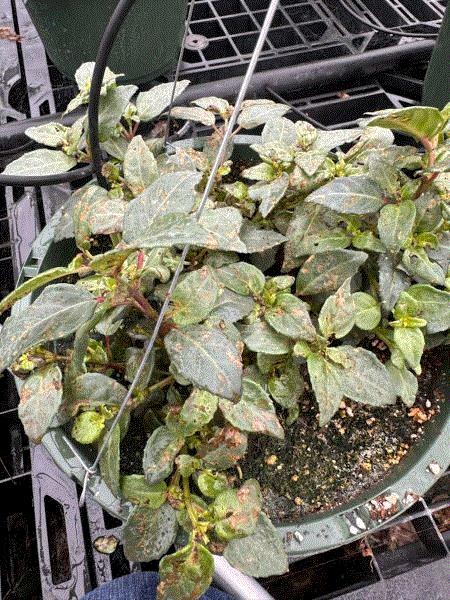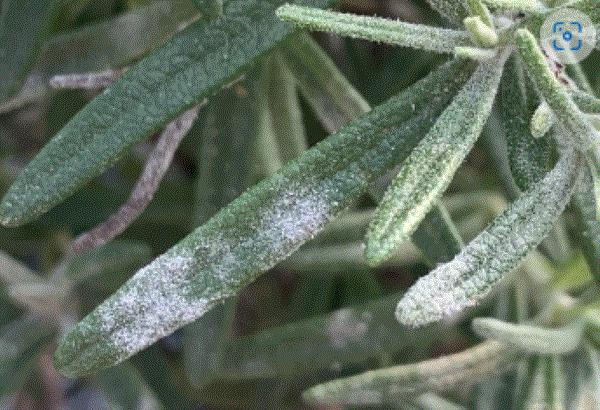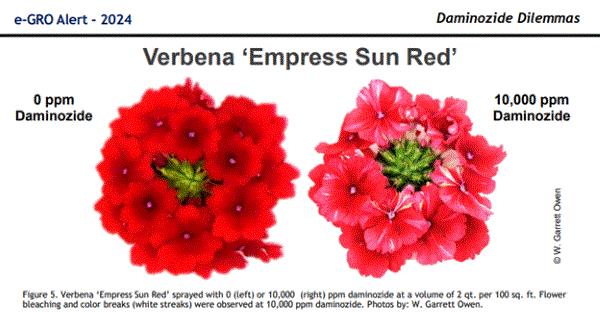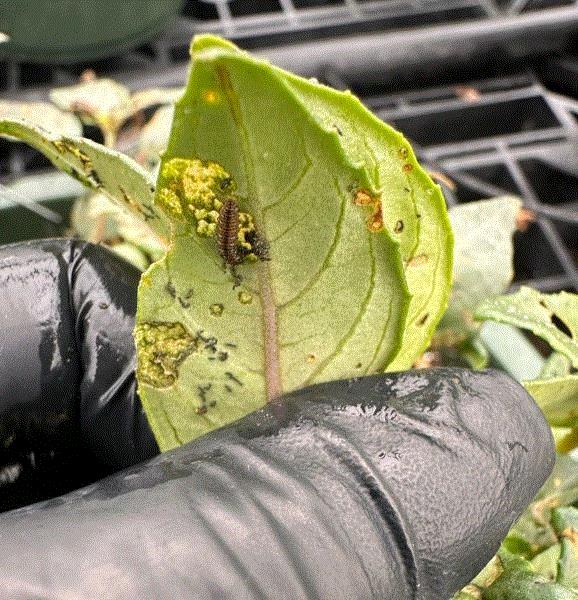What the ... ?
I received a couple of pictures of fuchsia suffering from skeletonization from a grower in Texas. “Window panes,” shotholes and necrosis of the damaged tissues were severe on heavily attacked plants.
What do you think was the culprit?

Ambrosia Beetle Survey
I devoted the previous issue of this newsletter to ambrosia beetles. (Go HERE for a copy.)
I mentioned that I conducted a survey of North Carolinian growers in 2020 and found 26% of the survey respondents suffered attacks from ambrosia beetles every year. Among those who suffered attacks, 44% lost more than $1,000 worth of trees, and 50% spent more than $1,000 on management (labor, equipment, insecticides, etc.) every year.

I put out this bolt trap last week and it's lit up with ambrosia beetle frass tubes within a week! Bolt trap is a great way to monitor for ambrosia beetle. See the previous issue of this newsletter on how to build a bolt trap.
It’s time to update those numbers and get inputs from a wider geographical region.
Please participate in a survey by going HERE. This survey is organized by the Stop Ambrosia Beetles team with the goal of understanding how ambrosia beetles impact your bottom line, what y’all do to deal with them, your outlook for 2024, and your preferred source of information. Some demographic information (no name) will be collected but the survey won’t share the personal or individual business information with anyone.
The time needed to complete the survey varies from one minute (if you answer you never had any ambrosia beetles attack in Page 3 of the survey) to 10 minutes (after answering all questions). Your answers will help us better understand the impact of ambrosia beetles and tailor our educational and outreach efforts to you.
Thank you for your help!

Get Ready for SLF
I contributed an article, “Getting ready for spotted lanternfly in 2024,” to this month’s issue of GrowerTalks. Go HERE for the article.
My original intention was to discuss a study published in September 2023 where a group of researchers from Pennsylvania State University (Penn State) concluded that spotted lanternfly (SLF) may be able to establish anywhere 991 degree-days may be accumulated. This is the magic number needed to support the complete development and reproduction of one generation of SLF. I read the study and wondered if SLF really has a good chance of establishment where I live. After all, Back Swamp, South Carolina, has accumulated more than 500 degree-days (50F threshold) as of March 19. A mere 991 degree-days is but a piece of cake.

Cumulated degree-days in the southeastern United States as of March 19, 2024. (Source: USPEST.org)
So, I called on my SLF guru, Brian Walsh of Penn State Extension, to get his outlook on SLF in 2024. Halfway through the discussion, I started to think this wasn’t a good idea since Brian didn’t really give me much good news.
I was told that SLF will continue to spread through human traffic and commerce, and there are plenty of host plants for SLF to feed on when arriving in the South (such as black walnuts, muscadines, red maples and crape myrtles). Unlike the tourists in Myrtle Beach, the SLF likely won’t leave. The only piece of good news is that folks are observing low SLF population in areas where SLF first invaded, but the intensity is still high at the front of invasion. That’s right, folks in some invaded counties in Virginia, Tennessee, North Carolina and elsewhere will continue to see active SLF activities for a few years.
While little damage to nursery crops have been reported, growers may be hit with the hassles and costs of complying to quarantine regulations and changing shipping practices. While SLF isn’t hard to kill, their sheer numbers and the associated hassles should persuade everyone to get ready for them.
Find out more about SLF in 2024 by going to the March issue of GrowerTalks.

National Green Industry Survey
The Horticultural Research Institute (HRI) is asking for your help in measuring changes in the green industry over the past five years by participating in the 8th National Green Industry Survey. Conducted since 1989, this survey documents the trends in production, marketing and retailing practices in the green industry. It’s a great way to see how green industry has changed.
You don’t have to be a grower or horticultural business manager or owner to contribute to an understanding of the green industry. If you are involved in any aspect of the green industry, you are invited to participate in the survey. I’m also eligible because I am a researcher of greenhouse and nursery pest management.
The survey is organized by researchers from North Carolina State University, University of Florida and University of Texas, with support from HRI. All information provided by you is strictly confidential. Results are only provided in summary form.
Go HERE to participate in the survey before May 1, 2024.
Disease Control on Herbs
Controlled environment agriculture (CEA) is something I never had much time to learn about in the past. CEA is a growing business, but pest management (particularly the use of pesticides) has been problematic and confusing. Since joining SePRO, I’ve been able to devote a little more time and energy to thinking about production of vegetables, herbs, fruits and their transplants indoor or in greenhouses.
I always think it’ll be nice if there is a resource where I can get all the pesticide information for CEA. Lucky me! Jean Williams-Woodward of the University of Georgia recently posted a note on e-GROBlog on disease management products for herb bedding plant production. Jean followed that with a full-length e-GRO article on powdery mildew on rosemary.

Powdery mildew on rosemary. (Photo credit: Jean Williams-Woodward, the University of Georgia)
What’s super useful in the blog is a link to a list of fungicides and biological products registered for use on herb bedding plants, compiled by Leanne Pundt of the University of Connecticut and Tina Smith of the University of Massachusetts a couple of years ago.
I want to echo Jean’s cautions in both the blog and the article—don’t think that all pesticides registered for use in greenhouses are legal to use on herbs. Few pesticides are labeled for culinary herb production in greenhouses because the herbs are intended to be eaten. So, please read your label before application!

Daminozide Bleaching of Flowers
In addition to disease control, another thing I need to learn about in my new job is plant growth regulators. I’m not joking when I say that I’m only an entomologist pretending to be a pathologist, weed scientist or horticulturist. The learning curve can be steep, but if y’all give me a little time, I’ll get there and be the know-it-all that I always wanted to be. One source that helps me get there is e-GRO newsletters and blogs, like the one I mentioned in the last story.
A recent article on e-GRO by Garrett Owen of The Ohio State University talked about the potential of flower bleaching when using daminozide. Daminozide is the active ingredient in B-Nine and Dazide. You’re probably using this plant growth regulator on some of your spring crops right now.
If you’re using daminozide, be aware of some potential issues that may occur at high application rates. Garrett demonstrated the effects using two plant species. Flower bleaching and color break occurred when verbena Empress Sun Red was sprayed at 5,000 and 10,000 ppm. Flower bleaching didn’t occur but bloom of calibrachoa Kona Red was delayed at 5,000 and 10,000 ppm. While folks don’t usually apply more than 5,000 ppm daminozide, it may happen if someone double-applied accidentally.
Garrett has nice photographs of the responses of these crops to daminozide treatment, and the reason why flower bleaching occurs, in the e-GRO article.

Garrett recommends the following approaches to avoid flower bleaching:
-
Check culture sheets for precautions on daminozide application.
-
Spray a lower dose of daminozide when it can be absorbed more effectively, such as during high humidity, on cloudy days, at low temperatures and in calm air.
-
Water the plants before application, but make sure leaves are dry during application.
-
Hold off overhead irrigation after application to allow for absorption.
-
Adjust application rates based on plant growth stage.
-
Do an in-house trial to determine the optimal application rate to achieve desirable characteristics of each species and cultivar.
-
Use other PGRs that achieve the same characteristics, such as ancymidol, chlormequat chloride, flurprimidol, paclobutrazol and uniconazole.
Also, this month on e-GRO, Garrett wrote an article on preventing rodent damage in overwintering greenhouses. Beth Scheckelhoff of The Ohio State University contributed an article on fern caterpillars. Fun reads.

Answer to “What the … ?”
This is a case of “I’m not sure but I have a guess.”
A close-up picture of the culprit damaging the fuchsia was also sent, which is very helpful. The fuchsia was attacked by some beetle larvae, more specifically leaf beetles or flea beetles. Not a redheaded flea beetle larva, which feeds on the roots; the larva in the picture fed on the leaf and didn’t look like a redheaded flea beetle larva at all.

My guess is a flea beetle of the genus Altica based on the shape and dotted appearance of the larva. Not 100% sure which species, however, since there are five flea beetle species known to feed on fuchsia, and the descriptions of larvae of these species are either poor or not available. Probably Altica litigata, which seems to prefer Onagraceae (the primrose family that includes fuchsia) and has been recorded from Texas (where the infestation occurred).
Many insecticides are effective against exposed flea beetle or leaf beetle larvae. In this case, the population was wiped out with bifenthrin before the grower received my recommendations. Other insecticides with good efficacy against exposed leaf beetle adults or larvae include acephate, carbaryl, pyrethroids (which there are many), neonicotinoids (acetamiprid, dinotefuran, imidacloprid and thiamethoxam), sulfoxaflor + spinetoram, spinosad, tolfenpyrad and diamides (chlorantraniliprole, cyantraniliprole and cyclaniliprole). After insecticide treatment and pruning, the plants may still have a chance to grow out of the damage before Mother’s Day.




See y'all next time!

JC Chong
Technical Development Manager at SePRO
Adjunct Professor at Clemson University
This e-mail received by 27,847 subscribers like you!
If you're interested in advertising on PestTalks contact Kim Brown ASAP!